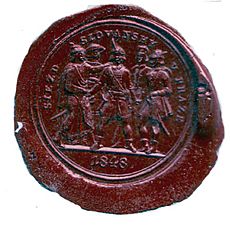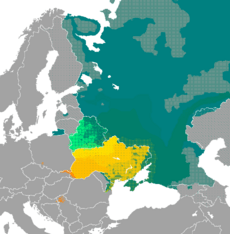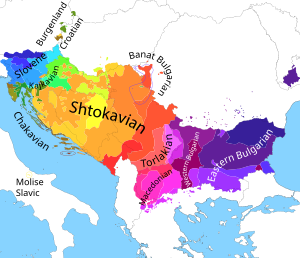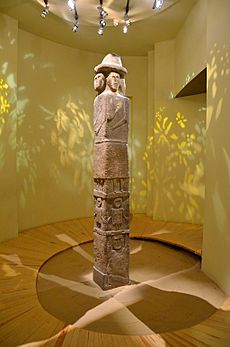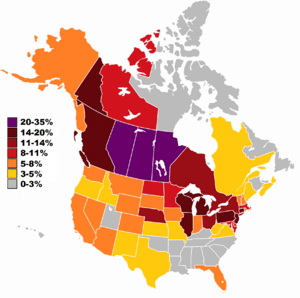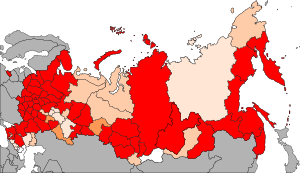Slavs facts for kids
| Total population | |
|---|---|
| see § Population | |
| Regions with significant populations | |
|
|
| Languages | |
| Slavic languages | |
| Religion | |
| Majority: Christianity (Orthodoxy and Catholicism) Minority:
|
|
| Related ethnic groups | |
| Other European peoples |
The Slavs are a large group of people who share a similar culture and speak Slavic languages. These languages are part of the bigger Indo-European language family. Slavs live mostly in Central Europe, Eastern Europe, and Southeastern Europe. You can also find many Slavs in the Baltics, Northern Asia, and Central Asia. Over time, many Slavs have also moved to the Americas.
Today, Slavs are divided into three main groups:
- The West Slavs include people like Czechs, Kashubians, Poles, Slovaks, and Sorbs.
- The East Slavs include Belarusians, Russians, Rusyns, and Ukrainians.
- The South Slavs include Bosniaks, Bulgarians, Croats, Macedonians, Montenegrins, Serbs, and Slovenes.
Most Slavs are Christians. However, some groups, like the Bosniaks, are mostly Muslims. Modern Slavic groups are very diverse. They have different genes and cultures. Their relationships can be friendly or sometimes even hostile.
Contents
What Does "Slav" Mean?
The word "Slav" first appeared in writings around the 500s AD. Writers like Procopius used names such as Sklaboi or Sklavenoi. In Latin, they were called Sclaveni.
The oldest Slavic writings from the 800s use the name Slověne. This word likely comes from an old Slavic word, *slověninъ. It means "people who speak the same language" or "people who understand each other." This is different from the Slavic word for "German people," which meant "silent" or "mute." The word slovo means "word," and slava means "glory."
History of the Slavs
Early History
Ancient Roman writings mention early Slavic people as the Veneti. They lived in central Europe around the 1st and 2nd centuries AD. This area was between the Vistula and Dnieper rivers.
In the early 500s, two Slavic tribes, the Antes and the Sclaveni, appeared in Byzantine records. Byzantine historians described these tribes coming from the Carpathian Mountains area. They invaded parts of the Eastern Roman Empire.
One historian, Jordanes, wrote in 551 AD that the Veneti were a "populous nation." He said they were the ancestors of the Antes and Sclaveni. Another writer, Procopius, said in 545 that the Sclaveni and Antae used to have one name: Sporoi. This name means "to sow" in Greek. He described them as strong foot soldiers who used shields, spears, and bows. They were tall and robust, with reddish skin and hair. They lived a hard life and often moved their homes. They believed in one god, "the maker of lightning," which was likely Perun.
Slavic Migrations
Slavic tribes were part of many groups in Eurasia before the Roman world knew them. These included the Sarmatian, Hun, and Gothic empires. Around the 5th and 6th centuries AD, Germanic tribes moved west. This started a big migration of the Slavs. They moved into lands left empty by the Germanic tribes.
Slavs spread west into areas between the Oder and Elbe rivers. They moved south into Bohemia, Moravia, and the Balkans. They also went north along the upper Dnieper River. Some even went with the Vandals to Spain and North Africa.
By the 6th century, many Slavs appeared at the Byzantine borders. Records say there were so many Slavs that grass would not grow where they had marched. Slavs even settled in the Peloponnese and Asia Minor. By the end of the 6th century, Slavs had settled in the Eastern Alps.
The Middle Ages

After the migrations, the first Slavic states began to form. Each state had a prince, a treasury, and a defense force. In the 600s, a Frankish merchant named Samo helped the Slavs fight their Avar rulers. He became the leader of the first known Slavic state in Central Europe, Samo's Empire. This state was important for later West Slavic states.
Other early Slavic states included Carantania and Great Moravia. The First Bulgarian Empire was founded in 681. It was an alliance between the ruling Bulgars and many Slavs. Their South Slavic language, Old Church Slavonic, became the official language in 864. Bulgaria helped spread Slavic writing and Christianity.
Later Slavic states included Kievan Rus', the Second Bulgarian Empire, the Kingdom of Poland, and the Kingdom of Croatia.
Modern Times
In the mid-1800s, a movement called Pan-Slavism became popular. It focused on the shared history and unity of all Slavic peoples. This was especially important in the Balkans, where South Slavs had been ruled by other empires for centuries.
By 1878, there were only three main Slavic states: the Russian Empire, Principality of Serbia, and Principality of Montenegro. Bulgaria became fully independent in 1908. Slavic people in the Austro-Hungarian Empire wanted to govern themselves.
After World War I ended in 1918, Slavs formed new independent states. These included Czechoslovakia, the Second Polish Republic, and the Kingdom of Serbs, Croats and Slovenes.
During World War II, some leaders had terrible plans for East and West Slavs. They wanted to remove or enslave many of them. This plan caused huge population losses, especially in Russia.
Today, former Soviet states in Central Asia, like Kazakhstan, have many Slavic people, mostly Russians.
Slavic Languages
All Slavic languages come from an ancient language called Proto-Slavic. This language was very similar across all areas. This suggests that the early Slavs lived in a relatively small area.
Today, there are many standardized Slavic languages. These include Belarusian, Bosnian, Bulgarian, Croatian, Czech, Macedonian, Montenegrin, Polish, Russian, Serbian, Slovak, Slovene, and Ukrainian. Russian is the most spoken Slavic language. It is also the most spoken native language in Europe.
Slavic languages use different alphabets. People who follow Orthodox Christianity usually use the Cyrillic alphabet. People who follow the Catholic Church usually use the Latin alphabet. Some languages, like Serbian and Montenegrin, use both alphabets.
Slavic Cultural Groups
Slavs are divided into three main cultural groups:
- West Slavs settled in Central Europe. They mixed with Germanic, Hungarian, and Celts people. They were influenced by the Western Roman Empire and the Catholic Church.
- East Slavs have roots in early Slavic tribes. They mixed with Finns, Balts, and Goths. They were also influenced by the Khazars and Vikings. Their history is linked to the Kievan Rus' state. They were strongly influenced by the Byzantine Empire and the Eastern Orthodox Church.
- South Slavs mixed with local groups like Illyrians, Dacians, and Thracians. They also mixed with Romans, Celts, and some invading tribes. Most South Slavs were influenced by the Byzantine Empire, the Ottoman Empire, the Eastern Orthodox Church, and Islam. However, Slovenes and Croats were influenced by the Western Roman Empire and the Catholic Church, similar to West Slavs.
Genetics
Studies of DNA show that East Slavs and West Slavs are very similar genetically. They are different from neighboring groups like Finno-Ugric and Turkic peoples. This genetic similarity is surprising because Slavic populations are spread out over a large area.
Genetic studies suggest that the Slavic expansion started from the area of modern-day Ukraine. This supports the idea that the earliest Slavic homeland was in the middle Dnieper River basin.
Religion
Early Slavic people followed pagan religions. They became Christian between the 600s and 1100s. Orthodox Christianity is common among East and South Slavs. Catholicism is common among West Slavs and some western South Slavs. These religious differences often match the split in the Christian church that happened in the 1000s. Islam came to the Balkans in the 600s and was adopted by some Slavic groups over time.
Most Christian Slavs are Orthodox, followed by Catholic. Most Muslim Slavs follow the Sunni branch of Islam. Usually, people in a Slavic ethnic group share the same religion.
|
Mainly Eastern Orthodoxy:
|
Mainly Catholicism: |
Mainly Islam:
|
Slavs and Other Peoples
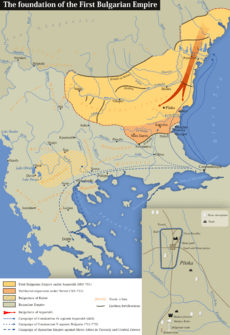
Throughout history, Slavs met and mixed with many non-Slavic groups. In their original homeland, they had contact with Iranian Sarmatians and Germanic Goths. As Slavs spread, they absorbed other peoples. For example, in the Black Sea region, Slavs absorbed the Goths. In the Balkans, they mixed with local groups like Illyrians and Thracians. Because there were so many Slavs, most local people in the Balkans became Slavic.
Greece is an exception. Here, Slavs became Hellenized (Greek) because there were more Greeks. Also, the church and government had a strong Greek influence. In Romania and Hungary, Slavs settled but were later absorbed into the local populations.
The Bulgars were a ruling group in Bulgaria. They were a Turkic tribe. But they gradually became Slavic and formed the modern Bulgarians. In Central Europe, West Slavs mixed with Germanic, Hungarian, and Celtic peoples. In Eastern Europe, East Slavs met Finnic and Scandinavian peoples. The Scandinavians (called Varangians) helped form the early Rus' state but became Slavic over time.
In the Middle Ages, some German miners settled in Bosnia, Serbia, and Bulgaria. They also became Slavic. The Cossacks are Slavic and Orthodox Christians. But they came from a mix of ethnic backgrounds, including Tatars. The Gorals in southern Poland and northern Slovakia have some ancestors from Romance-speaking Vlachs. These Vlachs moved into the region and were absorbed by the local people.
Population
It is estimated that there are about 300 million Slavic people living in Central, Eastern, and Southeastern Europe today.
| Ethnicity | Estimates and census data | |
|---|---|---|
| Belarusians |
|
|
| Bosniaks |
|
|
| Bulgarians |
|
|
| Croats |
|
|
| Czechs |
|
|
| Macedonians |
|
|
| Montenegrins |
|
|
| Poles |
|
|
| Russians |
|
|
| Rusyns |
|
|
| Serbs |
|
|
| Slovaks |
|
|
| Slovenes |
|
|
| Ukrainians |
|
|
See also
 In Spanish: Pueblos eslavos para niños
In Spanish: Pueblos eslavos para niños
- Ethnic groups in Europe
- List of modern ethnic groups
- List of Slavic tribes
- Pan-Slavic colors
- Slavic names



